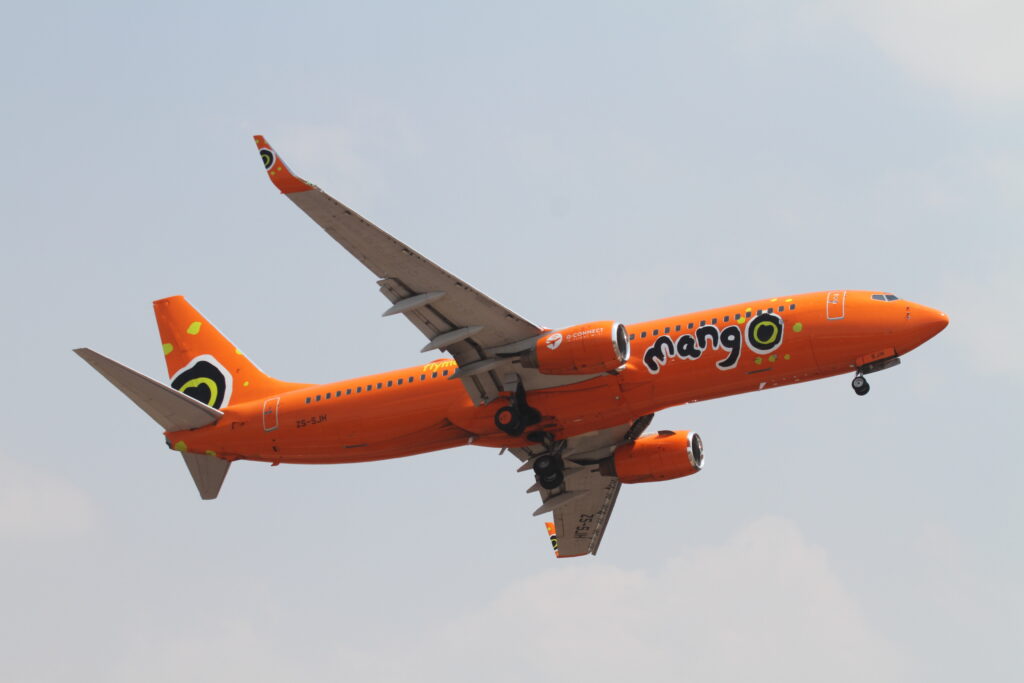
 The Rise of Mango Airlines
The Rise of Mango Airlines
Mango Airlines, established in 2006 as a subsidiary of South African Airways (SAA), quickly became a staple in South Africa’s aviation industry. Renowned for its vibrant orange livery and commitment to affordable air travel, Mango connected travelers to numerous destinations across South Africa and select SADC countries. Operating primarily from O.R. Tambo International Airport in Johannesburg, Mango offered budget-friendly flights that made air travel accessible to a broader demographic.
Financial Challenges and Business Rescue
Despite its popularity, Mango Airlines faced significant financial challenges in recent years. In July 2021, the airline entered voluntary business rescue due to mounting debts and operational difficulties. The business rescue process aimed to restructure the airline and address its financial issues. However, the situation deteriorated further, leading to the suspension of Mango’s operating licenses in August 2022 by the Air Services Licensing Council for a period of two years, citing the airline’s failure to operate for over 12 months .
Popular Routes and Connectivity
Before its suspension, Mango Airlines offered a range of domestic and regional flights, making air travel accessible to many. Some of the most popular routes included:
Additionally, Mango extended its services to select SADC destinations, promoting regional connectivity and tourism.
 The Impact on South Africa’s Aviation Landscape
The Impact on South Africa’s Aviation Landscape
The Impact on South Africa’s Aviation Landscape
The suspension of Mango Airlines left a significant gap in South Africa’s low-cost air travel market. With the concurrent challenges faced by other carriers, including Comair’s financial difficulties, travelers found fewer affordable options for domestic flights. This situation underscored the importance of budget-friendly airlines in promoting tourism and facilitating business travel within the country.
The Future: Prospects for Revival
Despite the challenges, there have been discussions about reviving Mango Airlines. The Department of Public Enterprises has expressed interest in restructuring the airline to ensure a sustainable low-cost carrier remains in operation. However, any potential revival would require significant investment, regulatory approvals, and a clear strategy to address the financial issues that led to Mango’s downfall .
A Tribute to Mango Airlines
Mango Airlines was more than just a carrier; it was a symbol of affordable travel and connectivity for many South Africans. Its distinctive orange aircraft became a familiar sight in the skies, and its commitment to customer service endeared it to passengers. While the airline’s future remains uncertain, its legacy continues to inspire discussions about the importance of low-cost carriers in South Africa’s aviation industry.
Why Mango Airlines Mattered to South African Travelers
One of the major reasons Mango Airlines resonated so deeply with South African travelers was its ability to offer affordable domestic flights with reliable service. In a country where land-based travel between major cities can take hours—or even days—Mango’s cost-effective air travel options helped bridge economic and geographic divides.
From last-minute cheap flights from Johannesburg to Cape Town to budget flights between Durban and Port Elizabeth, Mango Airlines provided essential connections for both business and leisure travelers. The airline didn’t just serve routes—it served lives. Students heading home for the holidays, entrepreneurs flying for meetings, families vacationing across the country—Mango made that possible at a fraction of the cost compared to full-service airlines.
Mango’s Value Proposition: Affordable, Reliable, and Customer-Friendly
With rising fuel prices and mounting airport taxes, many South African carriers struggled to maintain pricing structures that appealed to budget-conscious flyers. Mango Airlines stood out by balancing affordability with reliability. Some of its key advantages included:
- No-frills ticket options: Flyers only paid for what they needed—no extra baggage fees unless they opted for it.
- Consistent flight schedules: Mango offered frequent flights between South Africa’s top cities, such as Johannesburg, Cape Town, Durban, and Bloemfontein.
- On-time performance: Mango maintained a relatively strong record for flight punctuality compared to competitors.
- User-friendly mobile and online booking: Making it easy to compare prices, book flights, and manage reservations.
Mango Airlines and Regional Connectivity in SADC
While Mango was primarily a domestic airline, it also offered regional flights within the SADC region, such as flights to Zanzibar. This service was particularly vital for promoting intra-African tourism and offering a low-cost alternative to international carriers.
With these regional connections, Mango enabled travelers to explore SADC destinations without breaking the bank, contributing to the broader goal of regional economic integration and tourism development. Unfortunately, these routes also vanished with the airline’s suspension, disrupting tourism flows and regional travel access.
The Broader Trend: What Happened to South Africa’s Low-Cost Airlines?
The fall of Mango Airlines is not an isolated case. Kulula, another popular low-cost carrier under Comair, also collapsed in 2022. Comair, which operated both Kulula and British Airways in South Africa under a franchise agreement, filed for liquidation after entering business rescue proceedings—mirroring Mango’s fate.
This trend reveals a deeper systemic issue in South Africa’s aviation sector:
- Operational inefficiencies and lack of government support.
- Delays in financial interventions and licensing decisions.
- COVID-19 pandemic’s catastrophic effect on travel demand.
- Escalating operating costs with limited revenue buffers.
Without robust support structures, low-cost airlines in South Africa continue to struggle to survive, despite strong market demand and brand loyalty.
What Travelers Can Learn from the Fall of Mango Airlines
For frequent flyers, the disappearance of Mango Airlines serves as a reminder to diversify travel options. Travelers are now more cautious when booking with budget airlines in South Africa, especially for long-term planning.
Some lessons include:
- Book with travel insurance to protect against sudden flight cancellations or airline closures.
- Monitor airline news for updates on licensing, financial health, and possible suspensions.
- Opt for refundable or flexible ticket options, especially when booking months in advance.
Mango Airlines’ suspension also underscores the need for greater transparency in airline business operations, especially when the public’s travel plans—and money—are on the line.
Could a New Mango Take Flight?
There’s cautious optimism around the potential resurrection of Mango Airlines. According to a 2023 update from the South African Department of Public Enterprises (DPE), efforts were ongoing to identify an equity partner to relaunch the airline. But without a clear buyer or investment agreement, Mango remains grounded.
If revived, Mango would need to:
- Rebuild trust with former loyal customers.
- Reinstate profitable and in-demand routes like Johannesburg to Cape Town flights and Durban to Cape Town routes.
- Improve operational resilience with better risk management and financial oversight.
The airline’s well-known brand identity and loyal customer base give it a potential competitive edge—if managed correctly. But any new iteration of Mango must address the root financial and operational issues to avoid repeating history.
Alternatives to Mango Airlines: Where Do Travelers Fly Now?
With Mango gone, South African travelers have turned to other domestic airlines. Some of the current options include:
- FlySafair – Now South Africa’s largest low-cost carrier. Known for on-time performance and extensive domestic routes.
- Lift Airline – A newer entrant in the domestic market, offering flexible booking and modern aircraft.
- Airlink – While not budget-focused, it serves many regional destinations formerly covered by Mango.
- CemAir – A smaller operator focusing on regional and lesser-known routes.
While these airlines have picked up some of Mango’s former market share, ticket prices have increased due to reduced competition. Many travelers still miss Mango’s affordable airfares and excellent route availability, particularly during peak holiday seasons.
Final Thoughts: A Farewell to Mango Airlines
The story of Mango Airlines is more than a tale of a company in decline—it’s the story of how a single brand helped shape South Africa’s domestic air travel market. Mango flights brought families together, supported small businesses, and opened up the skies to thousands who couldn’t afford full-service carriers.
As travelers, we hope for a revival. As citizens, we call for stronger aviation policy. And as loyal customers, we remember Mango Airlines not for how it ended, but for how it helped us fly—bright, bold, and brilliantly orange.
The Role of Government in South Africa’s Airline Sector
The failure of Mango Airlines, much like the earlier demise of Kulula and Comair, has brought into sharp focus the role of government oversight and support in South Africa’s aviation industry. Mango, as a state-owned enterprise through its parent company South African Airways (SAA), was particularly vulnerable to delayed financial support and bureaucratic inefficiencies.
Critics have pointed out that sluggish responses from the Department of Public Enterprises (DPE) and insufficient bailout strategies led to the airline’s avoidable decline. There was also confusion over the proposed privatization of Mango and the sale of a majority stake to potential investors—something that was never finalized despite public statements supporting a relaunch (Fin24).
For Mango Airlines—or any new low-cost carrier in its place—to survive in the future, there must be:
- Transparent public-private partnerships.
- A clear aviation development policy supporting budget airlines.
- Swift funding during crises, like the COVID-19 pandemic, when travel demand plummeted.
Without this, South Africa may continue to lose vital domestic carriers that support tourism, business, and national mobility.
 The Economic Impact of Mango’s Absence
The Economic Impact of Mango’s Absence
The Economic Impact of Mango’s Absence
The absence of Mango Airlines has had a ripple effect across multiple sectors:
- Travel and tourism: With fewer flights available and increased airfares, both inbound and domestic tourism numbers have been affected, especially for budget-conscious travelers.
- Small businesses and SMEs: Many relied on Mango’s low fares to conduct face-to-face meetings and travel for work affordably.
- Airports and staff: Airports such as King Shaka International (Durban) and Cape Town International lost regular flight slots, which affected retail income, baggage services, and airport employment.
South Africa’s airline industry is a vital economic engine. The fall of Mango reminds us just how connected the industry is to broader economic performance.
What a Mango Revival Would Need to Succeed
Should Mango Airlines return to the skies—whether under its original brand or as a new low-cost airline—success would hinge on three key pillars:
- Lean, agile business operations: Cost efficiency must remain central without sacrificing safety or service.
- Digital innovation: Online booking, mobile apps, and customer communication channels must match global low-cost airline leaders.
- Customer trust rebuilding: Former Mango passengers were loyal. They’ll return—but only if transparency and reliability are front and center.
Moreover, Mango’s revival could benefit from strategic alliances with travel aggregators, voucher platforms, and loyalty programs to re-attract its former user base.
Remembering Mango: A Visual Journey
Travelers have taken to social media in recent years to share their memories of Mango Airlines—from snapshots of its iconic orange tail fin to in-flight selfies and family trips to Cape Town. Some travel influencers even launched nostalgic hashtag campaigns such as #BringBackMango and #FlyOrangeAgain, underscoring the deep affection the public had for the brand.
This brand love isn’t something easily replicated. It’s a powerful marketing advantage should Mango or a successor brand rise again.
Mango Airlines in Google Search: A Persistent Demand
Interestingly, even months and years after its grounding, Google search trends show that queries for “Mango flights,” “Mango Airlines bookings,” and “cheap flights to Cape Town on Mango” still persist. This highlights ongoing public interest and brand recall.
This level of organic search traffic reflects Mango’s entrenched role in the digital travel ecosystem. A successful relaunch could immediately capitalize on this demand and redirect searches into bookings.
Final Reflections: South Africa Needs Mango More Than Ever
In today’s post-pandemic world, where the cost of living is rising and travel is no longer considered a luxury but a necessity for many, South Africa needs affordable and reliable domestic airlines. Mango Airlines once filled that role with confidence, heart, and a distinct orange hue.
Its departure has made skies quieter—but also more expensive and less connected. Whether Mango returns or a new airline rises in its place, the need for accessible air travel remains as strong as ever.
Until then, Mango Airlines lives on in the memories of the millions it helped take flight.
Sources
Източник за тази статия
Наши спонсори са:
Български трактори на добри цени при изключително качество






